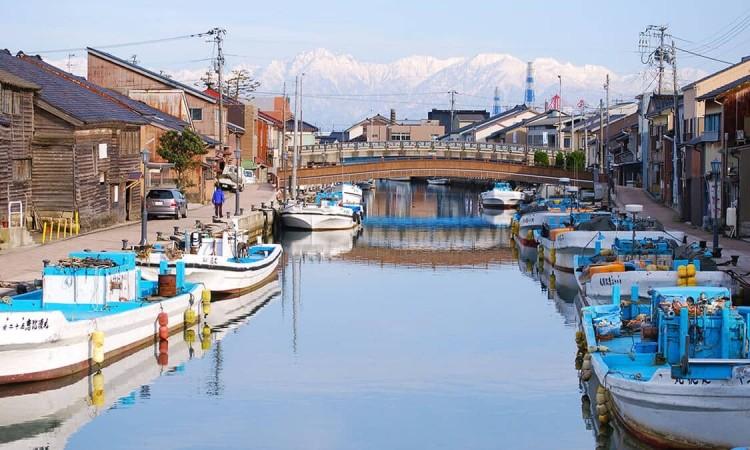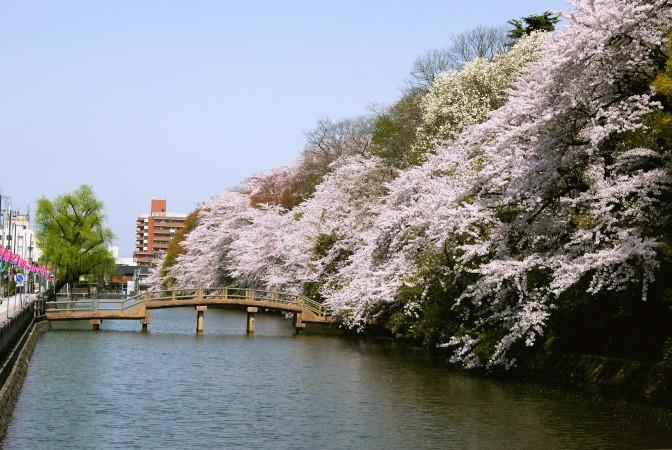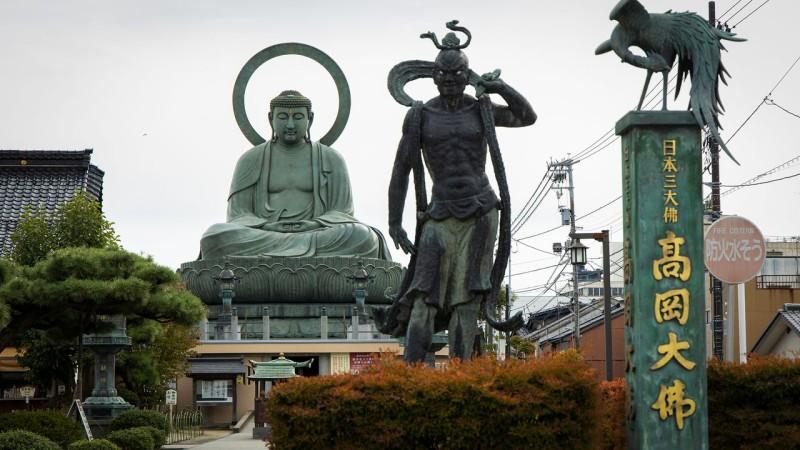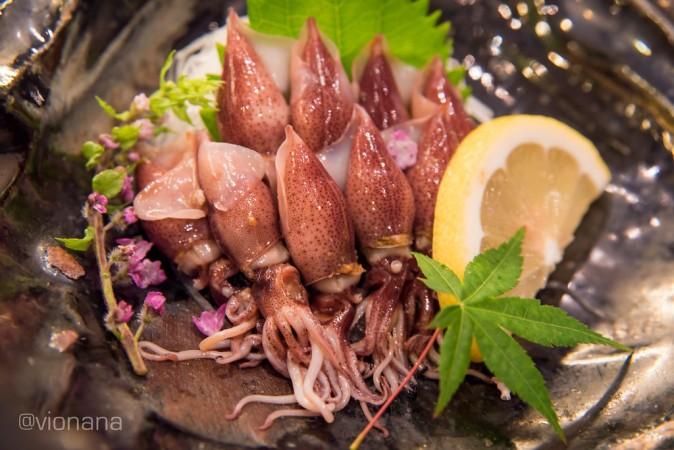Explore Takaoka - Japan Travel, Asia
Nestled in Toyama Prefecture, Takaoka is a city brimming with historical charm and modern attractions. This captivating destination offers a unique blend of ancient traditions and contemporary culture, making it an ideal spot for travelers seeking an authentic Japanese experience. Whether you're exploring its historical sites or savoring local delicacies, Takaoka promises an unforgettable journey.
Craving an exceptional Japan adventure? Explore our handpicked premium tours here for the ultimate experience.
Population: Approximately 173,000 in 2018.
Economy: Takaoka’s economy thrives on manufacturing, particularly copperware and metal crafts, alongside a growing service sector including tourism, and other local businesses.
Landmarks: Famous for the Takaoka Great Buddha, Zuiryu-ji Temple, and Kanayamachi.
Japan

Overview of Takaoka
History & Cultural Influence
Takaoka boasts a rich history that dates back to its founding by Maeda Toshinaga in 1609. As the second lord of the Kaga Domain, Toshinaga established Takaoka as a key cultural and economic hub. The influence of the Maeda Clan is still evident today, especially in the city's renowned craftsmanship. Along with the rich historical heritage, Takaoka's vibrant culture also left plenty of room for visitors to explore. One of Takaoka's most significant cultural contributions is its exquisite copperware. You can explore workshops and even try their hand at creating their own piece. Another must-visit is Zuiryu-ji Temple, a National Treasure of Japan, which showcases stunning architecture and serene gardens that reflect the city's spiritual heritage.
Interaction with The Locals
Takaoka has a population of approximately 173,000 residents. The citizens of Takaoka are known for their warmth and hospitality, making visitors feel welcome wherever they set feets on. The community is deeply rooted in tradition, with a strong emphasis on cultural heritage and craftsmanship. Despite modernization, the people of Takaoka maintain a harmonious balance between preserving their rich history and embracing contemporary life.

Takaoka-Shi, Tomaya Prefecture, Japan - © Tomaya Tourism
Top Attractions in Takaoka
Takaoka is home to a variety of attractions that cater to different interests. These attractions, steeped in history and natural beauty, showcase the diverse appeal of Takaoka, making them must-visit sites in Takaoka.
- Takaoka Great Buddha (Takaoka Daibutsu): One of Japan's top three Great Buddhas, the Takaoka Daibutsu stands 15.85 meters tall. This impressive bronze statue, completed in 1933, symbolizes the city's metallurgical prowess. Visitors can explore the temple grounds and learn about the statue's history and significance.
- Zuiryu-ji Temple: Designated a National Treasure, Zuiryu-ji Temple is a stunning example of early Edo-period architecture. The temple's beautifully landscaped gardens and intricate wooden structures offer a peaceful retreat for reflection and admiration.
- Kanayamachi: This historic district features well-preserved Edo-period houses and streets. Strolling through Kanayamachi feels like stepping back in time. The area is also known for its traditional shops selling Takaoka Copperware and other local crafts.
- Takaoka Castle Park: Built on the ruins of Takaoka Castle, this park is a favorite among locals and tourists alike. The expansive grounds include cherry blossom trees, ponds, and walking trails. It's an ideal spot for a leisurely stroll or a picnic.
- Amaharashi Coast: Famous for its picturesque views of the Tateyama Mountain Range, Amaharashi Coast is a must-see for nature lovers. The coast's scenic beauty changes with the seasons, offering breathtaking views year-round.

Takaoka Great Buddha Statue - © Nippon
Must-Try Dishes in Takaoka
Takaoka's culinary scene offers a delightful array of flavors that reflect the region's rich history and cultural heritage. Here are some must-try dishes:
- White Shrimp (Shiroebi): The uniqueness of white shrimp, frequently referred to as the "jewel of Toyama Bay," is definitely a specialty from the ocean that you just must try. It can be enjoyed as sashimi, tempura, or in a simple, sweet soy sauce marinade.
- Toyama Black Ramen: Though not exclusive to Takaoka, Toyama Black Ramen is a regional favorite with its dark soy-based broth, thick noodles, and rich flavors. It's a comforting dish perfect for a chilly day.
- Hotaru Ika (Firefly Squid): This seasonal delicacy, usually available in spring, features tiny, bioluminescent squids. They are typically served as sashimi or marinated in vinegar, offering a unique and refreshing taste.
- Buri (Yellowtail) Sashimi: Toyama Bay is famous for its buri, especially during the winter months. The yellowtail sashimi is incredibly fresh and rich in flavor, often enjoyed with soy sauce and wasabi.
- Miso Soup with Crab: Takaoka’s proximity to the sea means fresh crab is readily available. Miso soup made with local crab is a comforting and flavorful dish, offering a taste of the ocean's bounty.
- Botan Shrimp: Also known as peony shrimp, botan shrimp are prized for their sweet and delicate flavor. To bring forth their inherent sweetness, they are frequently served either lightly grilled or raw as sashimi.
Curious about Okayama? Learn more about what makes this spot so special in our detailed article.

Hotaru Ika - © Flickr
Festivals & Local Celebrations
Takaoka hosts a variety of vibrant festivals and local celebrations that showcase its rich cultural heritage and community spirit. These festivals and celebrations offer visitors a chance to experience Takaoka's vibrant cultural life and engage with the local community. Each event provides unique insights into the city's traditions and artistic heritage, making them essential experiences for any traveler.
Takaoka Mikurumayama Festival
Held in early May, this event is acknowledged as an Important Intangible Folk Cultural Property. Takaoka Mikurumayama Festival features ornate floats, called yama, that are paraded around the city. The floats, which are intricately designed and elaborately decorated with gold and lacquer, are a testament to Takaoka's historical craftsmanship. The highlight is the evening activities, when the floats are illuminated and create a surreal scene. A vibrant and joyous environment is created by the festival's traditional music and dance acts.
Takaoka Tanabata Festival
Celebrated in early July, this festival transforms the city with colorful decorations and traditional performances. Vibrant Tanabata bamboo branches decorated in paper strips and wish-granting decorations line the streets. The festival includes parades, live music, dance performances, and food stalls offering local delicacies. The highlight is the grand parade featuring beautifully decorated floats and participants in traditional attire, celebrating the legend of the star-crossed lovers, Orihime and Hikoboshi.
Zuiryu-ji Temple Autumn Festival
This October festival celebrates the changing seasons with traditional music, dance performances, and tea ceremonies within the serene grounds of Zuiryu-ji Temple. The celebrations have a breathtaking backdrop provided by the temple, which is a National Treasure of Japan. Visitors can enjoy classical Japanese performances such as Noh theater and koto music, as well as partake in tea ceremonies that offer a peaceful and reflective experience. The festival also features a market

Takaoka Mikurumayama Festival - © Toyama Tourism
What to Do in Takaoka
Takaoka offers a wide range of activities that cater to various interests, ensuring a memorable experience for every visitor:
- Historical Walking Tours: Explore Takaoka's rich history through guided walking tours that take you to key historical sites such as Takaoka Great Buddha, Zuiryu-ji Temple, and Kanayamachi's old town.
- Traditional Craft Workshops: Get hands-on experience in traditional Japanese crafts. Try your hand at Takaoka Copperware making or lacquerware workshops, where skilled artisans guide you through the process.
- Nature Excursions: Take advantage of Takaoka's scenic surroundings with outdoor activities. Visit Amaharashi Coast for breathtaking views of the Tateyama Mountain Range, or hike through the picturesque landscapes around the city.
- Cultural Experiences: Participate in tea ceremonies, ikebana (flower arranging) classes, and other cultural activities that offer a deeper understanding of Japanese traditions.
Shopping in Takaoka
Shopping in Takaoka offers a delightful mix of traditional and modern experiences, providing unique souvenirs and local products that reflect the city’s rich cultural heritage. Here are some of the best places to shop in Takaoka:
- Takaoka Daibutsu Market: This lively market is the perfect place to experience the local lifestyle. Here you'll discover handcrafted products, seafood, and fresh veggies. It’s also an excellent spot to pick up authentic souvenirs, such as locally crafted items and regional specialties.
- Kanayamachi: This historic district is famous for its traditional crafts, especially Takaoka Copperware. Stroll through the charming streets and explore specialty shops where you can purchase exquisite copper items, lacquerware, and other handmade crafts.
- Takaoka Lacquerware Hall: Dedicated to showcasing the city's renowned lacquerware, this hall offers a wide range of beautifully crafted items. You can find everything from elegant tableware to decorative pieces, all reflecting the high level of craftsmanship Takaoka is known for.
- Otaya Serio: Located near Takaoka Station, this shopping center combines retail stores with dining and entertainment options. It’s a convenient spot for visitors to explore a variety of shops, including local boutiques and well-known brands.
- Tokyu Department Store: This upscale department store features a variety of high-end brands and products. It’s a great place to find luxury items, including designer fashion, cosmetics, and gourmet foods.
- Nishimatsuya Chain: Specializing in affordable products for families, this chain offers a wide range of items, from clothing and accessories to toys and household goods. It’s a practical choice for everyday shopping needs.

Kanayamachi - © Japan Tourism
Weather in Takaoka: Best Time to Visit
Takaoka experiences a temperate climate with four distinct seasons, making it an attractive destination year-round.
- Spring in Takaoka: Takaoka’s spring is characterized by mild temperatures and blooming cherry blossoms with average temperatures can range from 10°C to 20°C (50°F to 68°F). This season is perfect for outdoor activities and enjoying the vibrant cherry blossom festivals.
- Summer in Takaoka: Takaoka’s summer sees warm and humid weather, with temperatures ranging from 20°C to 30°C (68°F to 86°F). It’s an excellent time for beach outings and exploring the lush green landscapes. Be prepared for occasional rain showers and pack light, breathable clothing.
- Autumn in Takaoka: Autumn is marked by cooler temperatures and stunning fall foliage. Average temperatures range from 10°C to 25°C (50°F to 77°F). This season is ideal for scenic hikes and participating in local harvest festivals. The scene is lovely thanks to the clear air and vibrant foliage.
- Winter in Takaoka: Winter in this region can be cold and snowy, with temperatures ranging from -2°C to 8°C (28°F to 46°F). The city occasionally receives heavy snowfall, transforming it into a winter wonderland. Skiing and snowboarding are available in neighboring mountain resorts for fans of winter sports. Make sure to dress warmly and prepare for icy conditions.
Essential Travel Information
Getting Around Takaoka
Navigating Takaoka is convenient due to its well-developed transportation network. The city’s central train station connects to major destinations and local areas, while an extensive bus system covers key attractions and neighborhoods. For a scenic and affordable option, the tramway offers easy travel within the city. Taxis provide a comfortable choice for those needing convenience, especially late at night or when carrying heavy luggage. Takaoka is also bicycle-friendly, with designated lanes and rental services for exploring at your own pace.
Explore the unique charm of Takayama, another must-visit place in Japan, in our article here.

Autumn in Takaoka - © Japan Tourism
ATM & Banking Services
Accessing banking services and ATMs in Takaoka is straightforward, ensuring you can manage your finances with ease. ATMs are widely available at convenience stores, train stations, and shopping centers, with many accepting international cards. Several banks in Takaoka offer various transactions, including currency exchange, with English-language support. While credit cards are accepted at most hotels, restaurants, and larger stores, it's advisable to carry some yen for smaller shops and traditional markets that may only accept cash.
Where to Stay in Takaoka
Takaoka offers a diverse range of accommodation options to suit various preferences and budgets. Visitors can choose from modern hotels with excellent amenities and convenient locations, traditional ryokans that provide a quintessential Japanese experience with tatami rooms and hot spring baths, and comfortable guesthouses and hostels that are perfect for tourists on a tight budget. Whether you prefer the comfort of a hotel, the charm of a ryokan, or the practicality of a guesthouse, Takaoka has a suitable option for every traveler.
Articles for you

Explore Yala National Park - Sri Lanka Travel, Asia
Tucked away in Sri Lanka’s southeastern corner, Yala National Park is where wild nature meets deep tradition. Known worldwide for its leopard population, the park is also home to elephants, sloth bears, crocodiles, and hundreds of bird species. Beyond wildlife, Yala opens doors to a cultural landscape dotted with ancient temples, Buddhist ruins, and coastal villages. For travelers seeking more than just a safari, Yala offers a chance to explore eco-tourism, local communities, and sacred heritage sites.
Population: The Yala National Park area doesn’t have a human population.
Economy: The economy around Yala National Park thrives on a blend of eco-tourism, agriculture, and local services. Safari tours, eco-lodges, and cultural experiences drive steady income for nearby towns like Tissamaharama and Kataragama, supporting thousands of families.
Landmarks: Famous for Block I of Yala and wildlife encounters, including elephants, sloth bears, crocodiles, and exotic bird species.

Explore Galle - Sri Lanka Travel, Asia
Nestled on Sri Lanka’s southern coastline, Galle is a vibrant city where history meets the sea. Its cobbled streets, colonial architecture, and serene beaches make it a must-visit destination for travelers seeking a blend of culture, adventure, and relaxation. A UNESCO World Heritage site, Galle captivates visitors with its Dutch Fort, bustling markets, and friendly locals. Whether you’re exploring the ramparts at sunset or savoring fresh seafood by the shore, Galle promises an unforgettable journey into Sri Lanka’s heritage.
Population: Approximately 113,000 in 2023.
Economy: Galle’s economy thrives on tourism, trade, and fisheries. The city’s historic fort, colonial architecture, and coastal charm draw thousands of international visitors each year, making tourism its main economic driver. Fishing remains vital for local livelihoods, supplying fresh seafood across the region.
Landmarks: Famous for the Galle Fort, Dutch Reformed Church & Maritime Museum, and Unawatuna Beach.

Explore Bentota - Sri Lanka Travel, Asia
Nestled along Sri Lanka’s southwestern coast, Bentota is a tropical paradise that blends golden beaches, vibrant culture, and thrilling adventures. Famous for its calm waters, luxury resorts, and scenic river estuary, Bentota has become a top destination for travelers seeking both relaxation and authentic experiences. From serene beach walks at sunrise to adrenaline-pumping water sports, this coastal town offers a perfect balance of leisure and exploration. With its proximity to Colombo and Galle, Bentota is easy to reach, making it an ideal stop for both short escapes and extended holidays.
Population: Approximately 37,000 in 2023.
Economy: Bentota’s economy thrives mainly on tourism, which drives local businesses such as hotels, restaurants, and wellness retreats. The town also benefits from fishing, coconut cultivation, and handicrafts like wood carving and batik textiles. Many residents rely on the growing demand for water sports and Ayurvedic treatments, making tourism the backbone of both income and employment in the area.
Landmarks: Famous for Bentota Beach, Bentota River Safari, and Kande Vihara Temple.

Explore Mirissa - Sri Lanka Travel, Asia
Mirissa is a charming coastal town on Sri Lanka’s southern shoreline. Known for its golden beaches, turquoise waters, and vibrant marine life, it has become a must-visit stop for travelers exploring the island. Many come for whale watching, surfing, and sunset views at Coconut Tree Hill, but Mirissa offers much more than postcard beauty. The fishing boats you see anchored by the bay carry generations of stories. Local traditions, delicious cuisine, and a laid-back rhythm of life shape every visitor’s experience.
Population: Approximately 4,700 in 2023.
Economy: Mirissa’s economy is largely shaped by its coastal location. Fishing has long been the backbone of local livelihoods, with generations relying on the Indian Ocean for income. In recent decades, tourism has become the main driver of growth, thanks to whale watching, surfing, and beachside hospitality.
Landmarks: Famous for Mirissa Beach, Coconut Tree Hill, and Parrot Rock Bridge.

Explore Nuwara Eliya - Sri Lanka Travel, Asia
Tucked away in the Central Highlands of Sri Lanka, Nuwara Eliya is often called “Little England”. With its rolling tea plantations, cool misty mornings, and colonial charm, this mountain town feels like a step into another world. Travelers come here to breathe fresh air, walk through flower gardens, sip the finest Ceylon Tea, and enjoy a pace of life far from the island’s busy cities. Whether you’re drawn by scenic landscapes, heritage architecture, or the warmth of its people, Nuwara Eliya is a destination that blends nature, culture, and history in perfect harmony.
Population: Approximately 781,000 in 2023.
Economy: Nuwara Eliya’s economy thrives mainly on tea production, as it sits in the heart of Sri Lanka’s central highlands, famous worldwide for Ceylon Tea. The city also benefits from a growing tourism industry, attracting visitors with its colonial charm, cool climate, and scenic landscapes.
Landmarks: Famous for Gregory Lake, Hakgala Botanical Garden, and Victoria Park.

Explore Sukau - Malaysia Travel, Asia
Nestled on the banks of the Kinabatangan River in Sabah, Malaysian Borneo, Sukau is a destination where wildlife, culture, and conservation come together. Known as one of Asia’s top spots for river safaris and eco-tourism, this quiet village offers a front-row seat to encounters with Bornean orangutans, pygmy elephants, proboscis monkeys, and exotic birdlife.
Population: Approximately 1,400 in 2019.
Economy: Sukau’s economy is shaped by its riverine location and natural resources. Traditionally, the Orang Sungai community relied on fishing, small-scale farming, and forest gathering for their livelihood. Today, the village has shifted toward eco-tourism, with river cruises, jungle trekking, and homestays providing income.
Landmarks: Famous for the Kinabatangan River cruises, Gomantong Caves, and Ox-bow lakes and wetlands.
